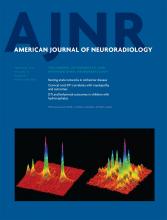Research ArticlePediatrics
Open Access
Bilateral Posterior Periventricular Nodular Heterotopia: A Recognizable Cortical Malformation with a Spectrum of Associated Brain Abnormalities
S.A. Mandelstam, R.J. Leventer, A. Sandow, G. McGillivray, M. van Kogelenberg, R. Guerrini, S. Robertson, S.F. Berkovic, G.D. Jackson and I.E. Scheffer
American Journal of Neuroradiology February 2013, 34 (2) 432-438; DOI: https://doi.org/10.3174/ajnr.A3427
S.A. Mandelstam
aFrom the Florey Neurosciences Institute (S.A.M., G.D.J., I.E.S.), Melbourne, Australia
bDepartments of Radiology (S.A.M.)
R.J. Leventer
cNeurology (R.J.L., I.E.S.)
dRoyal Children's Hospital and Department of Paediatrics (R.J.L., I.E.S.), University of Melbourne, Melbourne, Australia
fMurdoch Childrens Research Institute (R.J.L., G.M.), Melbourne, Australia
A. Sandow
eEpilepsy Research Centre (A.S., S.F.B., I.E.S.), Department of Medicine, University of Melbourne, Austin Health, Melbourne, Australia
G. McGillivray
fMurdoch Childrens Research Institute (R.J.L., G.M.), Melbourne, Australia
M. van Kogelenberg
gClinical Genetics Group (M.v.K., S.R.), Dunedin School of Medicine, University of Otago, Dunedin, New Zealand
R. Guerrini
hDivision of Child Neurology and Psychiatry (R.G.), University of Pisa and IRCCS Fondazione Stella Maris, Pisa, Italy.
S. Robertson
gClinical Genetics Group (M.v.K., S.R.), Dunedin School of Medicine, University of Otago, Dunedin, New Zealand
S.F. Berkovic
eEpilepsy Research Centre (A.S., S.F.B., I.E.S.), Department of Medicine, University of Melbourne, Austin Health, Melbourne, Australia
G.D. Jackson
aFrom the Florey Neurosciences Institute (S.A.M., G.D.J., I.E.S.), Melbourne, Australia
I.E. Scheffer
aFrom the Florey Neurosciences Institute (S.A.M., G.D.J., I.E.S.), Melbourne, Australia
cNeurology (R.J.L., I.E.S.)
dRoyal Children's Hospital and Department of Paediatrics (R.J.L., I.E.S.), University of Melbourne, Melbourne, Australia
eEpilepsy Research Centre (A.S., S.F.B., I.E.S.), Department of Medicine, University of Melbourne, Austin Health, Melbourne, Australia

References
- 1.↵
- Aghakhani Y,
- Kinay D,
- Gotman J,
- et al
- 2.↵
- Barkovich AJ,
- Kjos BO
- 3.↵
- Raymond AA,
- Fish DR,
- Stevens JM,
- et al
- 4.↵
- Dubeau F,
- Tampieri D,
- Lee N,
- et al
- 5.↵
- Li LM,
- Dubeau F,
- Andermann F,
- et al
- 6.↵
- Wieck G,
- Leventer R,
- Squier W,
- et al
- 7.↵
- Guerrini R
- 8.↵
- Guerrini R,
- Dobyns W
- 9.↵
- Parrini E,
- Ramazzotti A,
- Dobyns WB,
- et al
- 10.↵
- Caviness VS Jr.,
- Rakic P
- 11.↵
- Edelman G,
- Thiery J
- Rakic P
- 12.↵
- Rakic P
- 13.↵
- Sarnat HB
- 14.↵
- Dobyns WB,
- Guerrini R,
- Czapansky-Beilman DK,
- et al
- 15.↵
- Poussaint TY,
- Fox JW,
- Dobyns WB,
- et al
- 16.↵
- Ekşioğlu YZ,
- Scheffer I,
- Cardenas P
- 17.↵
- Fox JW,
- Lamperti ED,
- Eksioglu YZ,
- et al
- 18.↵
- Sheen VL,
- Basel-Vanagaite L,
- Goodman J,
- et al
- 19.↵
- Barkovich AJ
- 20.↵
- Robertson SP,
- Twigg SR,
- Sutherland-Smith AJ,
- et al
- 21.↵
- Van Essen D
- 22.↵
- Rakic P
- 23.↵
- Piao X,
- Hill R,
- Bodell A,
- et al
- 24.↵
- 25.↵
- Caviness VS Jr.
- 26.↵
- Toro R,
- Burnod Y
- 27.↵
- Geschwind N,
- Galaburda A
- Goldman-Rakic P,
- Rakic P
- 28.↵
- Van Essen D,
- Dierker D
- 29.↵
- Cendes F,
- Li L,
- Andermann F,
- et al
- 30.↵
- Salanova V,
- Markand O,
- Worth R
- 31.↵
- Rutherford M
- Tortori-Donati P,
- Rossi A
- 32.↵
- Andersen P,
- Morris R,
- Amaral D
- 33.↵
- Margariti P,
- Blekas K,
- Katxioti F,
- et al
- 34.↵
- Kivitie-Kallio S,
- Autti T,
- Salonen O,
- et al
- 35.↵
- 36.↵
- Katz MJ,
- Lasek RJ,
- Siler J
- 37.↵
- Kostovic I,
- Rakic P
- 38.↵
- 39.↵
- Mitchell L,
- Thomas P,
- Zacharin M,
- et al
- 40.↵
- Guerrini R,
- Mei D,
- Sisodiya S,
- et al
- 41.↵
- Solé G,
- Coupry I,
- Rooryck C,
- et al
- 42.↵
- Hannan AJ,
- Servotte S,
- Katsnelson A,
- et al
- 43.↵
- 44.↵
In this issue
Advertisement
S.A. Mandelstam, R.J. Leventer, A. Sandow, G. McGillivray, M. van Kogelenberg, R. Guerrini, S. Robertson, S.F. Berkovic, G.D. Jackson, I.E. Scheffer
Bilateral Posterior Periventricular Nodular Heterotopia: A Recognizable Cortical Malformation with a Spectrum of Associated Brain Abnormalities
American Journal of Neuroradiology Feb 2013, 34 (2) 432-438; DOI: 10.3174/ajnr.A3427
0 Responses
Bilateral Posterior Periventricular Nodular Heterotopia: A Recognizable Cortical Malformation with a Spectrum of Associated Brain Abnormalities
S.A. Mandelstam, R.J. Leventer, A. Sandow, G. McGillivray, M. van Kogelenberg, R. Guerrini, S. Robertson, S.F. Berkovic, G.D. Jackson, I.E. Scheffer
American Journal of Neuroradiology Feb 2013, 34 (2) 432-438; DOI: 10.3174/ajnr.A3427
Jump to section
Related Articles
Cited By...
- Long-term Outcome of Epilepsy and Cortical Malformations Due to Abnormal Migration and Postmigrational Development: A Cohort Study
- Evaluation of Subependymal Gray Matter Heterotopias on Fetal MRI
- Malformations of Cortical Development and Epilepsy
- Mystery Case: Bilateral posterior periventricular heterotopias
This article has not yet been cited by articles in journals that are participating in Crossref Cited-by Linking.
More in this TOC Section
Similar Articles
Advertisement











